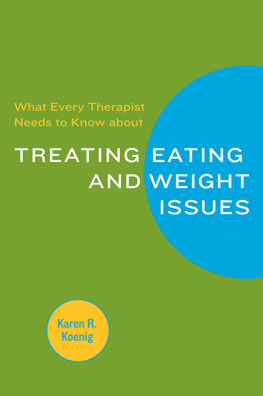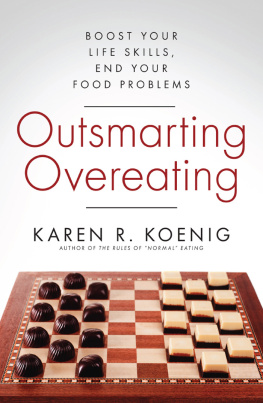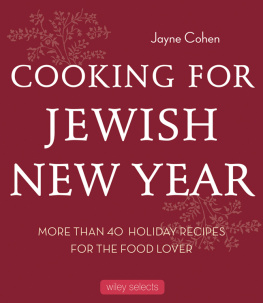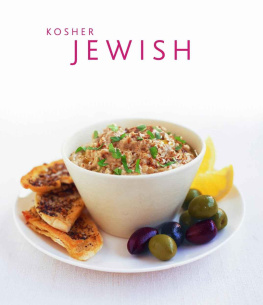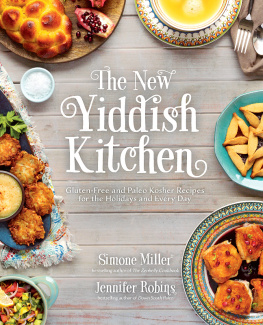
Text copyright 2015 by Leah Koenig.
Photographs copyright 2015 by Sang An.
All rights reserved. No part of this book may be reproduced in
any form without written permission from the publisher.
Library of Congress Cataloging-in-Publication Data available.
ISBN 978-1-4521-2748
ISBN ISBN 978-1-4521-3232-7 (epub, mobi)
Designed by Sara Schneider
Prop styling by Glenn Jenkins
Food styling by George Dolese and Elisabet der Nederlanden
Chronicle Books LLC
680 Second Street
San Francisco, California 94107
www.chroniclebooks.com
ACKNOWLEDGMENTS
This cookbook, like all books, would not exist without the hard work, patient advice, and genius insights of a whole team of people. Thank you to:
My agent Jenni Ferrari-Adler, who supported and encouraged me in shaping an idea into a proposal.
Bill LeBlond, who originally commissioned the book, my talented editor Sarah Billingsley, who shepherded it along the way, and the whole team at Chronicle Books.
Gabriella Gershenson for contributing the foreword and being a regular source of inspiration.
Kate Elias who helped me edit the manuscript, and whom Im thrilled to have as both a friend and now a professional collaborator.
The incredible photography and design team, including Sang An, George Dolese, and Sara Schneider. It is an honor to see how my recipes and words came alive under your creative care.
The many friends and family who helped test, taste, and tweak recipes along the developing process: Anna and Naf Hanau, Anya Rous, Dan Steingart and Rachel Kort, Devorah and Manor Klein Lev-Tov, Elizabeth Lambshead and Brett Mullin, Ellen Smith Ahern and Chris Ahern, Matt Carl, Eve Stoller and Chris Chavez, Eric Gold, Tamar Kornblum, Michael Kodransky, Stephen Klein, Hannah Giles and Preston Demouchet, Judith Belasco and Mark Berkowitz, Dana Dasch and Philippe Gerschel, Julie Dawson and Benjy Fox-Rosen, Chani and Eden Pearlstein, Liz Alpern, Liz Fisher and Jeremy Brown, Daniel Zana and Yaffa Vinikoor, Aliyah Vinikoor, Carol Koenig, Ora Fruchter and Bradford Jordan, Temim Fruchter, Dasi Fruchter, Sruly Lazaros and Shai Fuller, Russ Agdern and Marisa Harford.
Rozanne Gold, who offered invaluable insights at a critical moment in the books development.
My parents Carol Koenig and Richard Koenig, my brother Seth, my in-laws Rena and Chaim Fruchter, and my sisters-in-law Temim, Ora, and Dasi, for their support.
And finally, to baby Max, the best thing I ever made, and Yoshie Fruchter, whose love for kasha varnishkes and potato kugel is unmatched, for being my partner in all adventures large and small.
CONTENTS
FOREWORD
GABRIELLA GERSHENSON,
FOOD FEATURES EDITOR AT EVERYDAY WITH RACHAEL RAY MAGAZINE
When I first got to know Leah, we were working together at Saveur magazineI was starting there as an editor, and she was filling in for our research chief. We quickly became co-conspirators and friends, recognizing a shared predilection for cute pastry chefs and frequent snack breaks to the staff kitchen. We also bonded over our shared love of Jewish food, from the fragrant, nutty spice zaatar to the more old-fashioned but decidedly delicious farmers cheese.
During our brief time working together, Leah was immersed in all things Jewish. She was working on The Hadassah Everyday Cookbook, the official cookbook of the vaunted Hadassah Jewish womens organization. Meanwhile, I was gearing up to write my first feature story for the magazine about revisiting Riga, Latvia, with my parents, who hadnt been back since they left during the first wave of Jewish migration in the 1970s. Writing such a personal story requires a good sounding board, and I regularly turned to Leah for advice. The conversations would often turn to my grandmother and the role she played in instilling my love for Jewish traditions through the foods that she made. Though I was concerned that I was boring Leah, I couldnt help but notice how intently she listened.
Fast forward a few years. Leah has now written her second book on Jewish food, Modern Jewish Cooking, which comes as no surprise to me. The fact that it serves as a definitive handbook of holiday favorites and excellent classic dishesnoodle kugel? cheese blintzes? borscht? check, check, checkas well as everyday foods that embrace Jewish flavors beyond Europe, is not surprising either. Leah crafted these recipes not only for her readers but to explore her own roots, and to create her own traditions, too.
She approaches the Jewish food canon with a keen sense of perspective. After all, for thousands of years, Jews have been a wandering tribe of people without a homeland. Food-wise, that means that you end up eating a lot like your neighbors. In America, for example, we might view Eastern European food as Jewish food; but, in reality, Jewish food is polyglot. Which is why, in Modern Jewish Cooking, youll find a Mideast-inflected almond-date smoothie and Sephardi leek patties alongside Yiddishe kasha varnishkes (toasted buckwheat and bow-tie noodles) and American egg creams.
As for her timing in writing Modern Jewish Cooking, Leahs could not have been better. As she explores in her introduction and the personal and historical sidebars scattered throughout the book, now may be the best moment in modern history to rediscover Jewish food. This is a boom time for the cuisine, filled with hip, urban entrepreneurs rolling up their sleeves and making everything from artisanal gefilte fish to raw sesame halvah and hand-rolled bagels. Ethnic foods used to be something that our parents and grandparents hid in hopes of assimilating and thriving in society. Now, its the thing that sets us apart and makes our contribution unique.
Reading and cooking through her book, it is clear that Leah celebrates Jewish cuisine as a living, breathing thing. In many ways, she hews to traditionyou will find killer recipes for matzo brei and hamantaschen. Shes also included a chapter that explains the significance of the major Jewish holidays and the symbolic foods associated with them. But, like many contemporary cooks, Leah is committed to seasonality, and that sensibility finds delectable expressions in her recipes. For Sabbath dinner menus, for instance, she suggests Pumpkin-Apple Challah in the winter, Creamy Sorrel Soup with Harissa in the spring, Sourdough Gazpacho in the summer, and Rosemary-Maple Roast Chicken in the fall.
As ideal as this cookbook is for the starter Jewish kitchen, its just as wonderful for everyday eating, no matter what your background is. Who wouldnt want to tuck into a melty Mozzarella, Tomato, and Basil Frittata for breakfast, dive into crispy Chicken Schnitzel with Caper Vinaigrette for lunch, have a sweet slice of Kabocha SquashChocolate Chip Cake as an afternoon snack, or some tender Grilled Salmon with Orange and Herbs for dinner? With this comprehensive and thoughtful cookbook, Leah has created so much more than a primer. She has written a work that can be passed down from parent to child, or simply be an inspiration for dinner tonight. Its up to you.
INTRODUCTION
Growing up, I could have really used a bubbe (Yiddish for grandmother). Being raised in a Jewish home, I was exposed early on to the joys of briny corned beef and fluffy matzo balls swimming in chicken soup. But while I loved the way these foods tasted, the secrets of how to make them remained a mystery.
My bubbe, Bessie Sparber, passed away years before I was born. One of those intuitive, shoot-from-the-hip Jewish cooks, she used a juice glass to measure sugar and had a sixth sense for how to make a dish smell, feel, and taste just right. But she never had the opportunity to beckon me into the kitchen as only a grandmother can. And I never had the pleasure of standing next to her, one hand tucked protectively in her apron pocket, watching while she cooked. I inherited her name (my middle name is Bess), but not her recipe for gefilte fish. And while my mom can turn out a superbly juicy brisket and ethereal applesauce-topped potato latkes, it never occurred to me as a kid or a busy teenager to ask her how.
Next page

